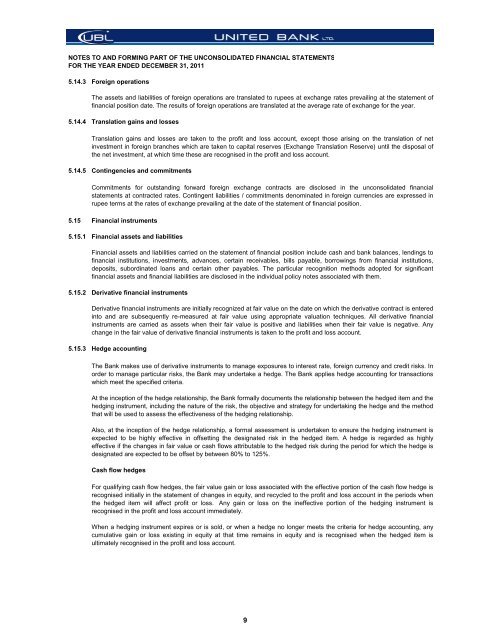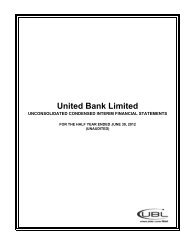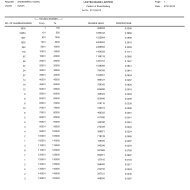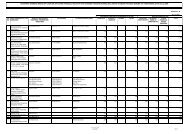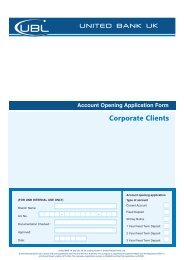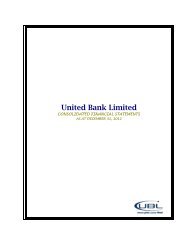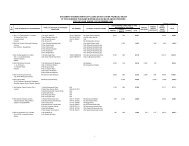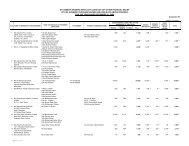UBL Financial Statements - United Bank Limited
UBL Financial Statements - United Bank Limited
UBL Financial Statements - United Bank Limited
You also want an ePaper? Increase the reach of your titles
YUMPU automatically turns print PDFs into web optimized ePapers that Google loves.
NOTES TO AND FORMING PART OF THE UNCONSOLIDATED FINANCIAL STATEMENTSFOR THE YEAR ENDED DECEMBER 31, 20115.14.3 Foreign operationsThe assets and liabilities of foreign operations are translated to rupees at exchange rates prevailing at the statement offinancial position date. The results of foreign operations are translated at the average rate of exchange for the year.5.14.4 Translation gains and lossesTranslation gains and losses are taken to the profit and loss account, except those arising on the translation of netinvestment in foreign branches which are taken to capital reserves (Exchange Translation Reserve) until the disposal ofthe net investment, at which time these are recognised in the profit and loss account.5.14.5 Contingencies and commitmentsCommitments for outstanding forward foreign exchange contracts are disclosed in the unconsolidated financialstatements at contracted rates. Contingent liabilities / commitments denominated in foreign currencies are expressed inrupee terms at the rates of exchange prevailing at the date of the statement of financial position.5.15 <strong>Financial</strong> instruments5.15.1 <strong>Financial</strong> assets and liabilities<strong>Financial</strong> assets and liabilities carried on the statement of financial position include cash and bank balances, lendings tofinancial institutions, investments, advances, certain receivables, bills payable, borrowings from financial institutions,deposits, subordinated loans and certain other payables. The particular recognition methods adopted for significantfinancial assets and financial liabilities are disclosed in the individual policy notes associated with them.5.15.2 Derivative financial instrumentsDerivative financial instruments are initially recognized at fair value on the date on which the derivative contract is enteredinto and are subsequently re-measured at fair value using appropriate valuation techniques. All derivative financialinstruments are carried as assets when their fair value is positive and liabilities when their fair value is negative. Anychange in the fair value of derivative financial instruments is taken to the profit and loss account.5.15.3 Hedge accountingThe <strong>Bank</strong> makes use of derivative instruments to manage exposures to interest rate, foreign currency and credit risks. Inorder to manage particular risks, the <strong>Bank</strong> may undertake a hedge. The <strong>Bank</strong> applies hedge accounting for transactionswhich meet the specified criteria.At the inception of the hedge relationship, the <strong>Bank</strong> formally documents the relationship between the hedged item and thehedging instrument, including the nature of the risk, the objective and strategy for undertaking the hedge and the methodthat will be used to assess the effectiveness of the hedging relationship.Also, at the inception of the hedge relationship, a formal assessment is undertaken to ensure the hedging instrument isexpected to be highly effective in offsetting the designated risk in the hedged item. A hedge is regarded as highlyeffective if the changes in fair value or cash flows attributable to the hedged risk during the period for which the hedge isdesignated are expected to be offset by between 80% to 125%.Cash flow hedgesFor qualifying cash flow hedges, the fair value gain or loss associated with the effective portion of the cash flow hedge isrecognised initially in the statement of changes in equity, and recycled to the profit and loss account in the periods whenthe hedged item will affect profit or loss. Any gain or loss on the ineffective portion of the hedging instrument isrecognised in the profit and loss account immediately.When a hedging instrument expires or is sold, or when a hedge no longer meets the criteria for hedge accounting, anycumulative gain or loss existing in equity at that time remains in equity and is recognised when the hedged item isultimately recognised in the profit and loss account.9


